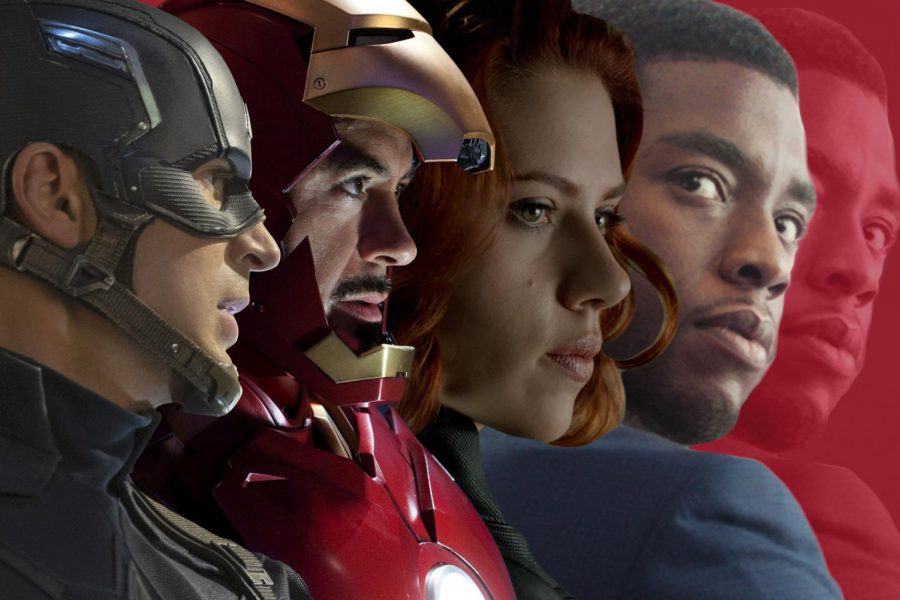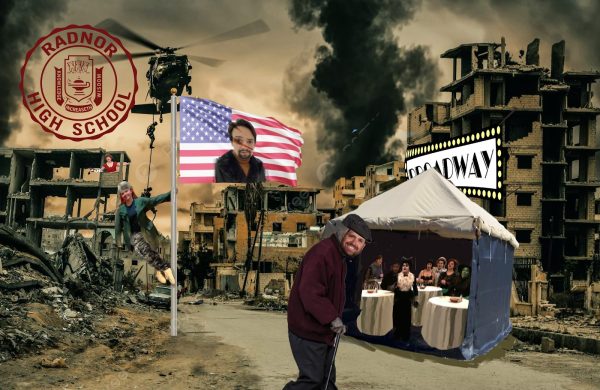A New Generation of Heroes, A New Generation of Tolerance
October 22, 2019
Seven million people each year wind through the cobblestone streets of Rome to enter the pantheon. The circular temple boasts a 360 degree view of statues of ancient Roman deities with a dome ceiling and oculus. The oculus allows a brilliant stream of light to act as a spotlight, highlighting one of twelve gods. Illuminating the sculptures’ exquisite features, the sun beam moves across the statues depending on the time of day. These works of art encompass the religion of ancient Rome, allowing spectators to view a piece of Roman culture.
In an era of advanced technology, mobile phones, and constant internet access, modern America’s equivalent of the pantheon and its symbolism is media. One such platform includes cinema, which provides a glance into the culture of the times and ever evolving philosophies. One example is the multi-billion dollar grossing franchise Marvel. Their movies provide not only a cinematic universe for superhero fans to indulge in and adore, but also a view into the beliefs and priorities of society at the time. As Marvel ended the third phase of their story in July of 2019, they presented a new generation of heroes in the Marvel Cinematic Universe (MCU), while still exemplifying a new generation of tolerance and acceptance.
MCU Phase 1
Beginning in 2008, using the stories laid out in the Marvel comics (from the mid-20th century), the movie franchise released six movies: Iron Man, The Incredible Hulk, Iron Man 2, Thor, Captain America:The First Avenger, and The Avengers. All six movies include male, white protagonists in their mid twenties to late thirties. While these movies premiered in the 21st century, they reflect a time in the past when gender, race, and age were represented in a narrow conformity.
In 2010, a female character and superhero is introduced (Natasha Romanoff/Black Widow) in Iron Man 2. However, her role is that of Tony’s assistant and she plays only a minor part in the final battle scene (she defeats only a dozen security guards, compared to Tony’s defeat of the main villain). Equipped with no superpowers or suits of armour, she has only manufactured weapons, Russian spy training, and a latex black bodysuit. Her role in Avengers (2012) is once again that of a second-tier hero in the battles, and her “talents” extend to use of a “damsel-in-distress” attitude or emotional vulnerability. In contrast, the heroes and villains of each movie are powerful men with gifted abilities, whether it be by science, self-invention, or birth as a god.
These heroes served as role-models for millions of people world-wide. However, these protagonists suggested a very closed-minded societal view and reflected the gender and racial issues facing the country. At the time, women faced significant inequality in schools, the workplace, and daily life. They faced sexual harassment, assault, and abuse, and endured criticism as they fought for equality. In February of 2012, Trayvon Martin was killed by George Zimmerman, sparking the Black Lives Matter movement and a dire call for change in society and its representation.
MCU Phase 2
In 2013, Marvel launched their second phase, releasing six more superhero movies in the next two years: Iron Man 3, Thor: The Dark World, Captain America: The Winter Soldier, Guardians of the Galaxy, Avengers: Age of Ultron, and Ant Man. These movies represent a step towards diversifying the Marvel universe and an evolving perception of tolerance in the world. However, like in the real world, these installments fail to variegate effectively. They display tumultuous times as they take two steps forward and one step back. While some movies in this era, like society, show promise and change, others illuminate room for growth.
In Iron Man 3, the main villain is initially introduced as “the Mandarin”, and is portrayed by a British and Indian actor Ben Kinglsey. This villain, seeming to be a step in the right direction towards a more inclusive cast, ultimately serves to act as the opposite. Viewers learn later in the movie, that “the Mandarin” is actually a native of New Jersey and a lackey to the true evil mastermind, Aldrich Killian, a cacausian male. Despite appearances of progress in society, peoples’ view of power remains a white male.
Guardians of the Galaxy, in contrast, takes a step in the right direction as aliens from all planets, skin tones, and ages are represented. Even though only one of the five Guardians, Gamora (played by Zoe Saldana), is female, she is known for her skill and acts independently, rebelling against her more powerful and oppressing father. This shows that females can be powerful and cool in their own right.
The second Avengers movie Avengers: Age of Ultron introduces a new female heroine: Scarlet Witch/Wanda Maximoff (played by Elizabeth Olsen). Her character is arguably the most powerful in the Marvel cinematic universe. Her powers include telekinesis, telepathy, flight, and several others unveiled throughout the coming years in the franchise. She underestimates herself and ultimately saves the day and becomes a hero and vital asset to the team. Olsen’s character was revolutionary in that she was young, female, and foreign. She sent a message of gender equality, inspiring millions of girls around the world to become their own hero.
In a time of immigration turmoil, Wanda Maximoff (Scarlet Witch) and her twin brother Pietro (Quicksilver) from Serbia illustrated a theme of unity. They showcased that when a threat arises, people from around the world can be on the same playing field with the same goal; together the world can surmount any obstacle when unified. While Avengers: Age of Ultron sent hopeful messages, Ant-man took a step back when main character Scott Lang beat out Hope Pym, daughter of Hank Pym (caucasian male) who was the brilliant scientist and mastermind behind the ant-suit. Hope trained her entire life to be a superhero and scientists like her father, but Scott Lang, an ex-con, was practically handed the suit and the protagonist role. This concept showcased that women had to be extraordinary to succeed, and yet could still be deprived of their dreams, while men can be average. This shocking approach displayed the harsh reality of our society and the need for improvement.
MCU Phase 3
In 2016, Marvel introduced Phase 3. In the next three years, they had 11 record-breaking movies including: Captain America: Civil War, Doctor Strange, Guardians of the Galaxy Vol. 2, Spider-Man: Homecoming, Thor: Ragnarok, Black Panther, Avengers: Infinity War, Ant-Man and the Wasp, Captain Marvel, Avengers: Endgame, Spider-Man: Far from Home. During this phase, Marvel displayed that the see-saw had tipped in favor of tolerance, diversity, and inclusion.
The third installment of the Captain America series included dozens of diverse superheroes, both male and female, from all walks of life, countries, ethnicities, and ages. Breaking the stereotypical mold of what a superhero should be, such as the “perfect” Captain America, this film showed that while people like Steve Rogers might exist, they are not the only people that can save the day. Guardians of the Galaxy Vol. 2 once again displayed characters from dozens of planets with different skin tones, genders, and races, exhibiting there is no limit to what a superhero can be.
Spider-Man: Homecoming, Thor: Ragnarok, Black Panther, Avengers: Infinity War, Ant-Man and the Wasp, Captain Marvel, Avengers: Endgame, Spider-Man: Far from Home all included female heroines and sometimes even villains. They showed that women could not only stand on their own, but could also save galaxies, and that people of all ages can make a difference. Black Panther broke box office records with its all black cast and female warriors, shattering previous comic book stereotypes. Marvel’s third phase encapsulated the growing acceptance in culture and marked a step towards a more united community.
MCU Phase 4
In the next few years, Marvel is expected to launch Phase 4. With movies including Black Widow, Falcon and the Winter Soldier, The Eternals, Shang-Chi and the Legend of the Ten Rings, WandaVision, Doctor Strange and the Multiverse of Madness, Loki, What If..?, Hawkeye, Thor: Love and Thunder, and Black Panther 2, the MCU is truly showing a new era of tolerance by displaying female, black, and asian characters, both young and old. Marvel has shown that anyone, from anywhere, can be a hero. With the power of acceptance, the world (whether it includes superheroes or not), can learn a valuable lesson. We must celebrate our differences, not ostracize, isolate, and hide them. With a new generation of tolerance in our world, comes a new generation of heroes.







